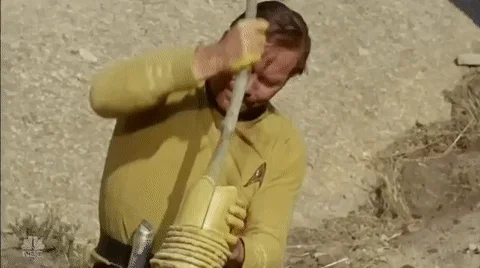Originally published at: Check in on the Voyager probes | Boing Boing
…
Didn’t Captain Kirk have a run in with this?

Voyager 1 has been travelling for 44 years, moving at a speed where it could travel from the earth to the moon in just over six hours, and still isn’t even one light DAY away from earth.
Man will never travel to the stars.



Note that this is an estimated status updated at 2hz. If you want to see realtime status of when we’re actually talking to (or just listening) to the voyager spacecraft you can look at the Deep Space Network page DSN Now. Look for connections to VGR1 and VGR2.
This is a website I didn’t know needed to exist! Thanks!
Also, I notice that Voyager 2 launched before Voyager 1. Now I have to look up why that is the case. My guess: they have nameplates attached to them, meaning it isn’t just a mission name.
Voyager 1 would reach Jupiter first; thus the name.
20 Aug 1977 Voyager 2 Launches
5 Sep 1977 Voyager 1 Launches
Voy2 ahead by 18 days
5 Mar 1979 Voyager 1 encounters Jupiter (349,000 kilometers)
9 Jul 1979 Voyager 2 encounters Jupiter (570,000 kilometers)
Voy 1 ahead by 126 days
9 Nov 1980 Voyager 1 encounters Saturn (124,000 km)
25 Aug 1981 Voyager 2 encounters Saturn (101,000 km)
Voy 1 ahead by 289 days
24 Jan 1986 Voyager 2 encounters Uranus (81500 km)
25 Aug 1989 Voyager 2 encounters Neptune (4950 km)
16 Dec 2004 Voyager 1 Crosses the Termination Shock
30 Aug 2007 Voyager 2 Crosses the Termination Shock
25 Aug 2012 Voyager 1 enters interstellar space
5 Nov 2018 Voyager 2 enters interstellar space.
I don’t have that kind of time to waste!
Right now Madrid is connected to VGR1.
That is cool, and so very SCIENCE!
Thanks! 
After encountering Saturn, Voyager 1 is knocked out of the plane of the ecliptic.
I found a paper that explains the different trajectories.
Voyager 2 was launched from Cape Canaveral, Flor- ida, on August 20, 1977, followed on September 5, 1977, by Voyager 1, which was on a faster trajectory optimized for a close flyby of Io at Jupiter and of Titan at Saturn. The slower Voyager 2 trajectory was chosen to allow the option of using gravity assist at Saturn to continue on to Uranus and Neptune, although such a trajectory would have precluded a close Titan flyby and radio occultation by Saturn’s rings. These and other Saturn objectives were achieved by the successful Voyager 1 encounter on November 12, 1980, and NASA subsequently approved the Uranus aimpoint option for Voyager 2, with a Saturn flyby on August 26, 1981, and a Uranus flyby on January 24, 1986.
Not sure, but the captain of a Klingon vessel used one as target practice in one of the movies, I think?
You could get to Alpha Centuari in about 60 years with a nuclear salt-water rocket.
Nuclear salt-water rocket - Wikipedia.
Probably actual people are too brief and too squishy to make it to the stars, but it should be possible for some man-made computer intelligence.

I feel like we missed an opportunity not sending out a stream of these. Say one every 10 years. Technology would improve and it’s not like we’re going to find a faster way there. As it is, we’re going to have to wait at least 44 years to send better instrumentation this far.
This topic was automatically closed after 5 days. New replies are no longer allowed.


